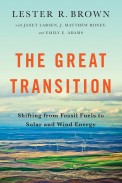Tuesday, October 26, 2010
Over the past six months Lester Brown and our amazing research team has been working on a new book. Now that we have put it into the hands of our publishers, we can tell you about it.
World on the Edge: How to Prevent Environmental and Economic Collapse will be released in January 2011. If you pre-order your copy today, you can get it in December.
Here’s an excerpt from Chapter 1, On the Edge:
The media described the 2010 heat wave in Russia and the flooding in Pakistan as natural disasters. But were they? Climate scientists have been saying for some time that rising temperatures would bring more extreme climate events. Ecologists have warned that as human pressures on ecosystems mount and as forests and grasslands are destroyed, flooding will be more severe.
The signs that our civilization is in trouble are multiplying. During most of the 6,000 years since civilization began we lived on the sustainable yield of the earth’s natural systems. But in recent decades humanity has overshot the level that those systems can sustain.
We are liquidating the earth’s natural assets to fuel our consumption. Half of us live in countries where water tables are falling and wells are going dry. Soil erosion exceeds soil formation on one third of the world’s cropland, draining the land of its fertility. The world’s ever-growing herds of cattle, sheep, and goats are converting vast stretches of grassland to desert. Forests are shrinking by 13 million acres per year as we clear land for agriculture and cut trees for lumber and paper. Four fifths of oceanic fisheries are being fished at capacity or overfished and headed for collapse. In system after system, demand is overshooting supply.
Meanwhile, with our massive burning of fossil fuels, we are overloading the atmosphere with carbon dioxide (CO2), pushing the earth’s temperature ever higher. This in turn generates more frequent and more extreme climatic events, including crop-withering heat waves, more intense droughts, more severe floods, and more destructive storms.
The earth’s rising temperature is also melting polar ice sheets and mountain glaciers. If the Greenland ice sheet, which is melting at an accelerating rate, were to melt entirely, it would inundate the rice-growing river deltas of Asia and many of the world’s coastal cities. It is the ice melt from the mountain glaciers in the Himalayas and on the Tibetan Plateau that helps sustain the dry-season flow of the major rivers in India and China—the Ganges, Yangtze, and Yellow Rivers— and the irrigation systems that depend on them.
We are facing issues of near-overwhelming complexity and unprecedented urgency. Can we think systemically and fashion policies accordingly? Can we move fast enough to avoid economic decline and collapse? Can we change direction before we go over the edge?
That’s what World on the Edge is all about. We’ve posted the Table of Contents and Chapter 1 online so you can get a preview of the book.
Sincerely,
Reah Janise Kauffman
Vice President
Page 1 of 1 pages




